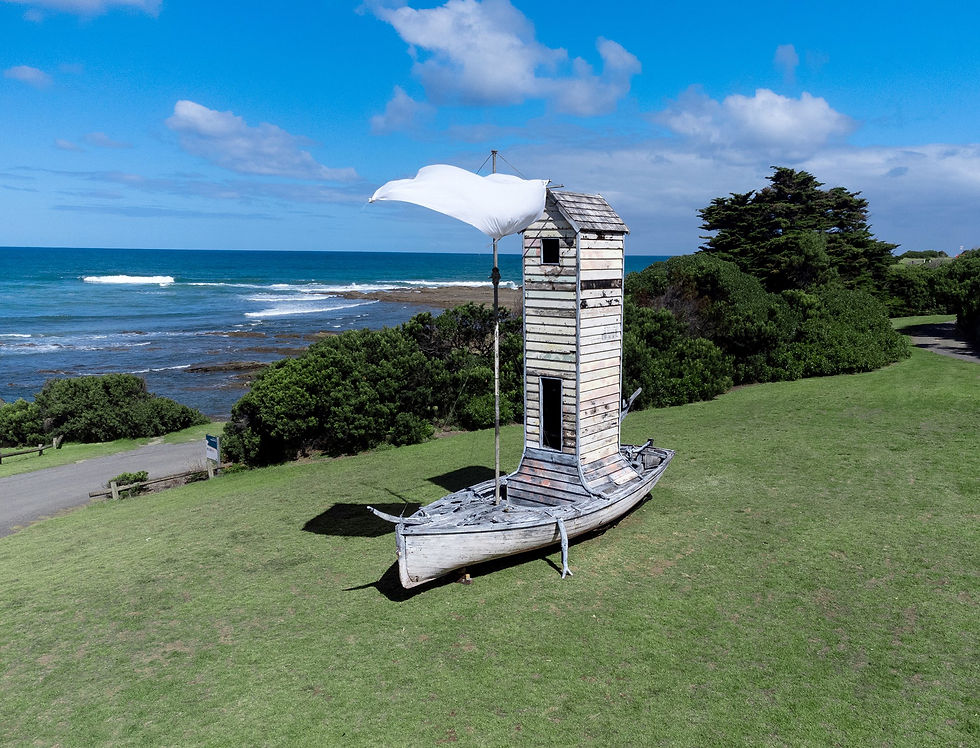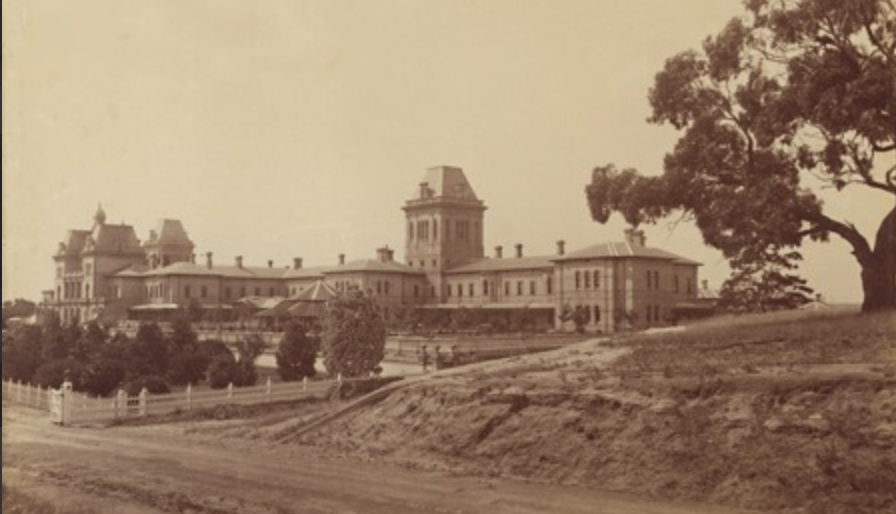Spirit of Place: The Lorne Sculpture Biennale, sacred symbols, and the challenge of coexistence
- Andrew McIlroy
- Apr 5, 2022
- 4 min read
Updated: Apr 10, 2022

In an era when art is often not for posterity, dismantled or cast aside after a short time, sculpture is by nature the more enduring, and when placed in public places the more accessible art form.
And while many artists today seem concerned with asking banal questions and “raising issues around” society’s pains, taking us nowhere, the minimalist simplicity and authority of sculpture gives hope that our cultures have not lost their way.
Breaking down this year’s epic Lorne Sculpture Biennale into 16 bite-size foreshore precincts where selected artists are bravely free to create new experiences, “highlighting the diverse influences that make Lorne unique as a magnificent natural location and one of fascinating human activity both now and in the past”[i] sums up the complexities of our national story.
Built on Gadubanud land the tourism hotspot of Lorne is today home to some of Australia’s most expensive homes. Holidaymakers choke the Great Ocean Road during the summer months. Crowds flock to its pristine beaches and walking trails. This sacred place whose indigenous inhabitants once lived, hunted and foraged unhindered has over the centuries tragically been denied them.

Patti Beerens, 'Dwell' (2022) Photo: Patti Beerens
Regrettably, we have only slowly come to understand that for aboriginal people the relationship to land runs much deeper.
Palyku woman Ambelin Kwaymullina explains:
For aboriginal peoples, country is much more than a place. Rock, tree, river, hill, animal, human - all were formed of the same substance by the ancestors who continue to live in land, water, sky. Country is filled with relations speaking language and following law, no matter whether the shape of that relation is human, rock, crow, wattle. Country is loved, needed, and cared for, and country loves, needs, and cares for her peoples in turn. Country is family, culture, identity. Country is self.[ii]
That is why the removal of Aboriginal people from their ancestral lands has been so disastrous because the loss of country leads to loss of language and culture.[iii]

Ambelin Kwaymullina Photo: University of Western Australia
Exploring the themes of art, nature and ritual this sculpture exhibition holds within its hands the potential to connect our histories and deal with the challenge of coexistence and reconciliation, hopefully breaking new ground to reveal something extraordinary and undoubtedly something strange within our multilayered story.
The sculpture trail begins from the south and travels north along the beach foreshore. Unapologetically, we experience at first themes that commemorate white settlement. But looking at the artists’ response, we learn much more about coexistence and the challenges this presents.
The scale of this exhibition that additionally includes performance, conversations and music is too large to capture in its entirety here. So, here is listed but a sample.
Precinct One: 'Tramway', Geoffrey Riccardo
Artist Geoffrey Ricardo is a comical figure no doubt. He wants you to see him that way. It belies a more serious, thoughtful side we are assured. A fitting gateway artist for this event.
Ricardo’s sculpture is absurd and delightfully unforgettable. Its lighthouse structure shaped from the form of an old weathered rail signal box, with views obscured by a fluttering mainsail dangling from a retired hoist clothesline nullifies its singular purpose. All this sitting improbably atop an old timber boat, rather than abreast stable, high ground.

Geoffrey Ricardo, 'Tramway' (2022) Photo: Lorne Sculpture Biennale
Tramway is a nod to the once nearby timber industry, where felled timber stripped from the Otway ranges was habitually dragged below for transport to Melbourne. Here, the scope of the artist’s comic inventiveness is on full display leading us towards a beguiling juxtaposition - of such utilitarian land use contrasting with the sacred care for land by Indigenous inhabitants.
Precinct Four: 'What Remains', Robert Hague
It is difficult to write about monuments in this context and not include multi-discipline artist Robert Hague. Nor would the narrative of this exhibition be complete without a consideration of the importance of the Golden Mile precinct as a Gadubanud meeting place, and a site of feast and celebration.[iv]
The grand features of the natural world along this stretch of foreshore contrast with the trappings of wealth here on full display, the desirability of ownership of land and restrictions on access.
Hague’s classical, deconstructed sculptures expose richly decorative fragments not unlike the broken crockery long scattered to break up the soil for drainage, interminably it seems rising to the surface of our garden beds. It is clear from Hague’s archaeological reference that these commonly desired material things are fragile and short lived, and evidence the more insubstantial world.

Robert Hague's neo-classical sculptures were popular with festival goers Photo: Robert Hague
Precinct Six: 'Remember Me', Maree Clarke
Maree Clarke is a proud Yorta Yorta/Wamba Wamba/Boonwurrung woman and described as a pivotal figure in the reclamation of southeast Australian Aboriginal art practices, reviving lost or dormant elements of culture since colonisation.[v]
Clarke’s poignant work of reflective acrylic paint, calico, tape and cotton thread poignantly weaving through the foreshore landscape draws a focus on the sacred vitality of the ocean to indigenous cultures. At its core, this work deals with the brutal legacy of colonialisation, the disregard of sacred symbols, and the tensions arising from loss of culture on coexistence and reconciliation.

Maree Clarke, 'Remember Me' (2022) Photo: National Indigenous Times
At its conclusion, this year’s Lorne Sculpture Biennale trail, leaves the wanderer alone, perhaps a tad breathless, on an ancient shoreline with it one hopes an renewed respect for the beliefs, practices and rights of Indigenous Australians within contemporary Australia and fresh insight into the fundamental challenge of the reconciliation of different world views into a more cohesive future.
Main Photo: Robert Hague, 'What Remains' (2022) Photo: Lorne Sculpture Biennale
i Nicola Dowse, TimeOut, 15 Nov 2020 ii Ambelin Kwaymullina, ‘Seeing the Light: Aboriginal Law, Learning and Sustainable Living in Country’, Indigenous Law Bulletin May/June 2005, Volume 6, Issue 11 [iii] Meaning of land to Aboriginal people, Creative Spirits 2019 [iv] Artist's Brief, Lorne Sculpture Biennale 2022 [v] Artist Description, Lorne Sculpture Biennale 2022



Comments